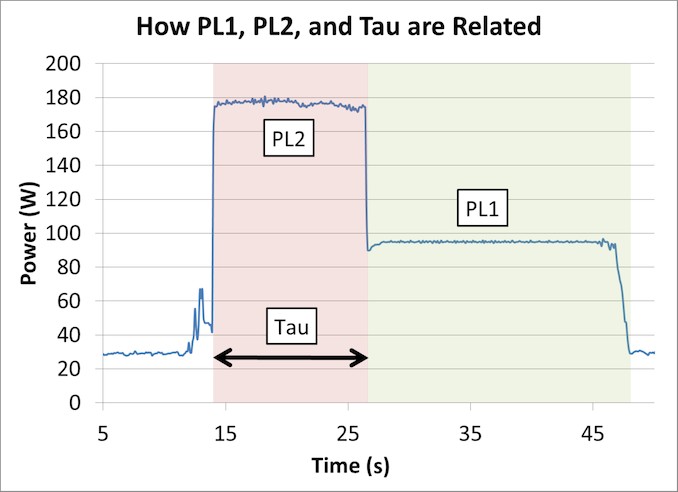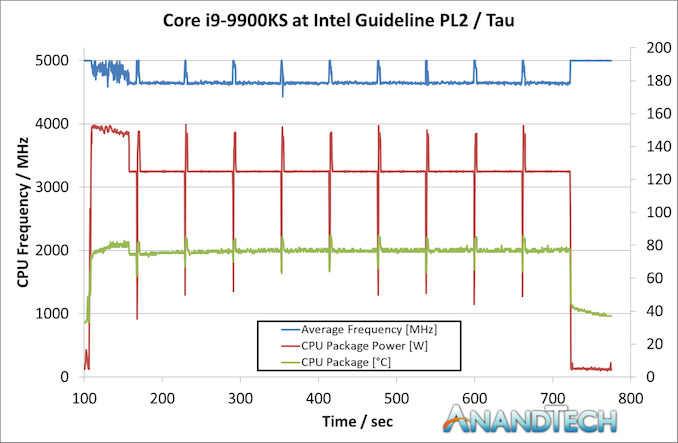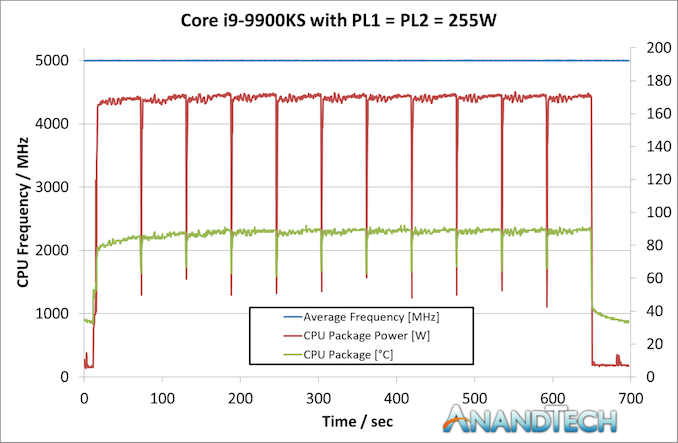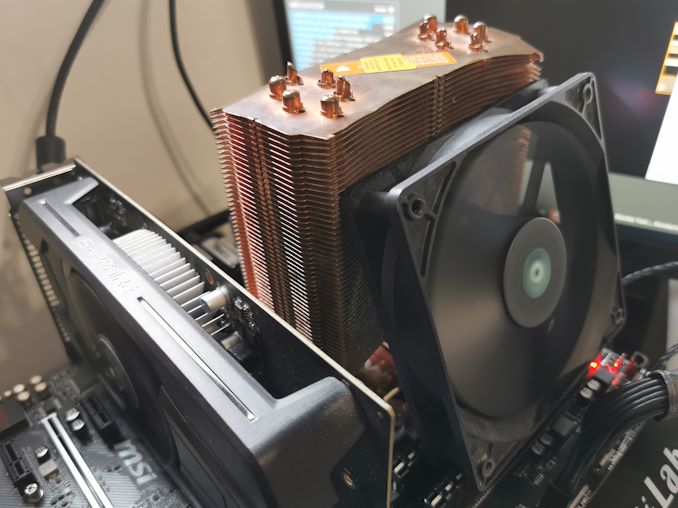The Intel Core i9-9900KS Review: The 5 GHz Consumer Special
by Dr. Ian Cutress on October 31, 2019 10:45 AM ESTGoing for Power
How to Manage 5.0 GHz Turbo
Intel lists the Core i9-9900KS processor as having a 127W TDP. As we’ve discussed at length [1,2] regarding what TDP means, as well as interviewing Intel Fellows about it, this means that the Core i9-9900KS is rated to require a cooling power of 127W when running at its base frequency, 4.0 GHz. Above this frequency, for example at its turbo frequency of 5.0 GHz, we are likely to see higher than 127W.
Now, I started saying in this review that the length of time that the processor will spend at 5.0 GHz will be motherboard dependent. This is true: Intel does not strictly define how long turbo should be enabled on any processor. It allows the motherboard manufacturer to ‘over-engineer’ the motherboard in order to help push the power behind the turbo higher and enable turbo for longer. The specific values that matter here are called PL2 (Power Limit 2, or peak turbo power limit), and Tau (a time for turbo).
For an Intel processor, each one has a ‘bucket’ of extra turbo energy. As the processor draws more power above its TDP (also called PL1), the bucket is drained to provide this energy. When the bucket is empty, the processor has to come back down to the PL1 power value, and eventually when the processor is less active below PL1, the bucket will refill. How big this bucket is depends on the value of PL1, PL2, and Tau. The bigger the bucket, the longer an Intel processor can hold its turbo frequency. Typically Tau isn’t so much as a time for turbo, but a scalar based on how big that bucket should be.

An example graph showing the effect of implementing Turbo on power/frequency
Motherboard manufacturers can set PL1, PL2, and Tau as they wish – they have to engineer the motherboard in order to cope with high numbers, but it means that every motherboard can have different long turbo performance. Intel even suggests testing processors on high-end and low-end motherboards to see the difference. Users can also manually adjust PL1, PL2, and Tau, based on the cooling they are providing.
For the Core i9-9900KS, Intel has given the PL1 value on the box, of 127 W. PL2 it says should at least be 1.25x the value of PL1, which is 159 W. Tau should be at least 28 seconds. This means, with a given workload (typically 95% equivalent of a power virus), the CPU should turbo up to 159 W for 28 seconds before coming back down to 127 W. A very important thing to note is that if the CPU needs more than 159 W to hit the 5.0 GHz turbo frequency, it will reduce the frequency until it hits 159 W. This might mean 4.8 GHz, or lower.
Despite giving us these numbers for PL1, PL2, and Tau, Intel also stated to us that they recommend that motherboard manufacturers determine the best values based on the hardware capabilities. The values of 127 W, 159 W, and 28 seconds are merely guidelines – most motherboards should be able to go beyond this, and Intel encourages its partners to adjust these values by default as required.
We tested Intel’s guidelines with a 10 minute run of Cinebench R20.
He we can see that at idle, the CPU sits at 5.0 GHz. But immediately when the workload comes on, it has to reduce the average CPU frequency because it goes straight up to the 159W limit – simply put, 159W isn’t enough to hit 5.0 GHz. We see the temperature slowly rise to 92C, but because the power isn’t enough the frequency keeps fluctuating.
By the end of the first Cinebench R20 section, it seems that the majority of it occurred during the turbo period. This means that this run scored almost the same as a pure 5.0 GHz run. However the subsequent runs were not as performant.
Because the turbo budget had been used up, the processor had to sit at 127 W, its PL1 value. At this power, the processor kept bouncing between 4.6 GHz and 4.7 GHz to find the balance. The temperatures in this mode kept stable, nearer 80C, but the performance of Cinebench R20 dropped around 8-10% because the CPU was now limited by its PL1/TDP value, as per Intel’s base configuration recommendation.
Going Beyond
Because motherboard manufactuers can do what they want with these values, we set the task on the motherboard we tested, the MSI Z390 Gaming Edge AC. By default, MSI has set the BIOS for the Core i9-9900KS with a simple equation. PL1 = PL2 = 255 W. When PL1 and PL2 are equal to each other, then Tau doesn’t matter. But what this setting does is state that MSI will allow the processor to consume as much power as it needs to up to 255 W. If it can hit 5.0 GHz before this value (hint, it does), then the user can turbo at 5.0 GHz forever. The only way that this processor will reduce in frequency is either at idle or due to thermal issues.
Here’s the same run but done with MSI’s own settings:
The processor stayed at a constant 5.0 GHz through the whole run. The CPU started pulling around 172W on average during the test, fluctuating a little bit based on exactly which 1s and 0s were going through. The CPU temperature is obviously higher, as we used the same cooling setup as before, and peaked at 92C, but the system was fully table the entire time.
Here was our system setup – a 2kg TRUE Copper air cooler powered by an average fan running at full speed in an open test bed.
But what this means is that users are going to have to be wary of exactly what settings the motherboard manufacturers are using. For those of you reading this review on the day it goes live, you’ll likely see more than a dozen other reviews testing this chip – each one is likely using a different motherboard, and each one might be using different PL2 and Tau values. What you’ve got here are the two extremes: Intel’s recommendation and MSI’s ‘going to the max’. Be prepared for a range of results. Where time has permitted, we’ve tested both extremes.













235 Comments
View All Comments
Maxiking - Thursday, November 7, 2019 - link
Shame you don't complain so much about AMD CPUs unable to reach promised boost clocks as much as you care about Intel power consumption. We get it, you are poor, you could finally afford 8 cores thanks to AMD yet loosing to Skylake refresh crippled by security patches so venting your frustration here. Difficult time to be an AMD fan, especially after the first gen threadripper support drop fiasco, suddenly a new socket and no backward compatibility is not an issue. Don't hate things just because you can't afford them. Fridays for future is up today again, vent your problems there, thanks. Anyway, bye, a private plane is waiting, gonna have a pizza for dinner in Italy to piss off Greta because I can.jonbar - Friday, November 8, 2019 - link
"Skylake refresh crippled by security patches" - you must be kidding, right? It shouldn't have those security holes. Please stop talking shit about poor because people here talk about optimization - the best for the least money at a price point. And please stop bashing AMD's ryzen - it's not bulldozer, without ryzen this shit here would be sold as "Intel i11 Unobtanium Edition" for 1k$ and you, rich boy, would have 6 cores or more only on LGA 2011.Nobody hates a product - I don't like Intel practices - 5% increase per generation to the point. Where my i7 3840qm is 10-15% slower than 7700hq with a 4! generations gap.
Speaking about private planes - nobody gives 1 cent on rich boys approach on tech at this level because, while you can afford stupid - the rest of us have to be smart. Now you can fly eat your pizza:)
Korguz - Friday, November 8, 2019 - link
wow maxiking... resorting to insults and name calling still ?? still believing all the intel bs ?? still believe intels bs about how much power their cpus use ?? talking like you have money is supposed to impress people ?? good for you.. nice to see you are also arrogant rich spoiled bratMaxiking - Friday, November 8, 2019 - link
How dare you? Where did I name call anyone? If someone is fat and I call them fat or if they smell and I tell them so, it is not an insult, it is called stating a fact.I see you still do not get the TDP does not mean power consumption, it is even stated and explained in the review.
If I were you, I would be more concerned about 1700x, 1800x, 2700x, 3900x TDPs and AMD misleading marketing about boost frequencies because there have been so far 3 bios patches which were supposed to fix the issue and guess what. Nothing has changed. People have to use a makeshift custom power profile created by a geek in order to get closer to the promised boost clocks.
Typical AMD, I give it 3 months till he starts fixing their awful gpu drivers aswell.
Korguz - Friday, November 8, 2019 - link
calling people poor.. among many other things in previous posts by you.. and yes it is an unsult to call some one fat.. or they smell.. but, i bet you do that because either your selfesteem, and self worth is so low, you have to say things like that to make your self feel better..yet you still cry about ryzen and the clock speeds.. but yet. you STILL refuse to admit the fraud intel calls is tdp spec ?? so what ever maxipadking . go back to your cave...
Maxiking - Sunday, November 10, 2019 - link
Yeah, my self esteem is so low that I regularly visit Mercedes and BMW showrooms only to tell them how they cars are overpriced and my Dacia is cheaper and can perform the same and consuming less gass like you do. If Intel TDP is fraud, so does is AMD's one and their promised boost clocks and video on youtube where they promise you can overclock chips even further with sufficient cooling. What do they mean by that? Ay, and what about the bulldozer fraud?Korguz - Sunday, November 10, 2019 - link
yea sure you do, your the one who is probably poor... you are becoming the worst intel shill on here now.... all you EVER do is talk. if you are so sure amd is committing fraud as you claim, then put your supposed money where your mouth is, and take AMD to court,m or shut upMaxiking - Monday, November 11, 2019 - link
Again, it is you, you and only you perpetuating lies. I never come here first talking **********, I only reply to amdfanboys comments.I do not own any AMD cpu, I do not buy subpar products so I can not take them to court.
Anyway, if you are so sure about Intel wrongdoings, take them to the court. EZ.
Unfortunately for you, it is AMD who lost at court and got caught misleading about that parody on cpu called bulldozer. Claiming to possess 2 times more cores than they actually had.
This is your AMD marketing in a nutshell
https://cdn.vox-cdn.com/uploads/chorus_asset/file/...
QQ more. Deal with it.
Korguz - Monday, November 11, 2019 - link
maxipadking.. you are so full of it... what about the intel lies about its 10nm nodes for the last what.. 6 years being on track ?? what about the lies about their not doing anything wrong to prevent amd feom selling its products ?? among various other things over the years that you so easily for get... you never come here 1st ?? BS actually.. you DO buy sub par products.. intel is sub par now.. but in your intel blindness.. you just dont see it... intels marking has been worse over the years then amd.. deal with that.keep QQing more about it... your good at it..
Gastec - Tuesday, November 19, 2019 - link
Maxiking, this is a tech site, not your favourite social network for trolling. Your shameless trolling should be punishable with a ban.